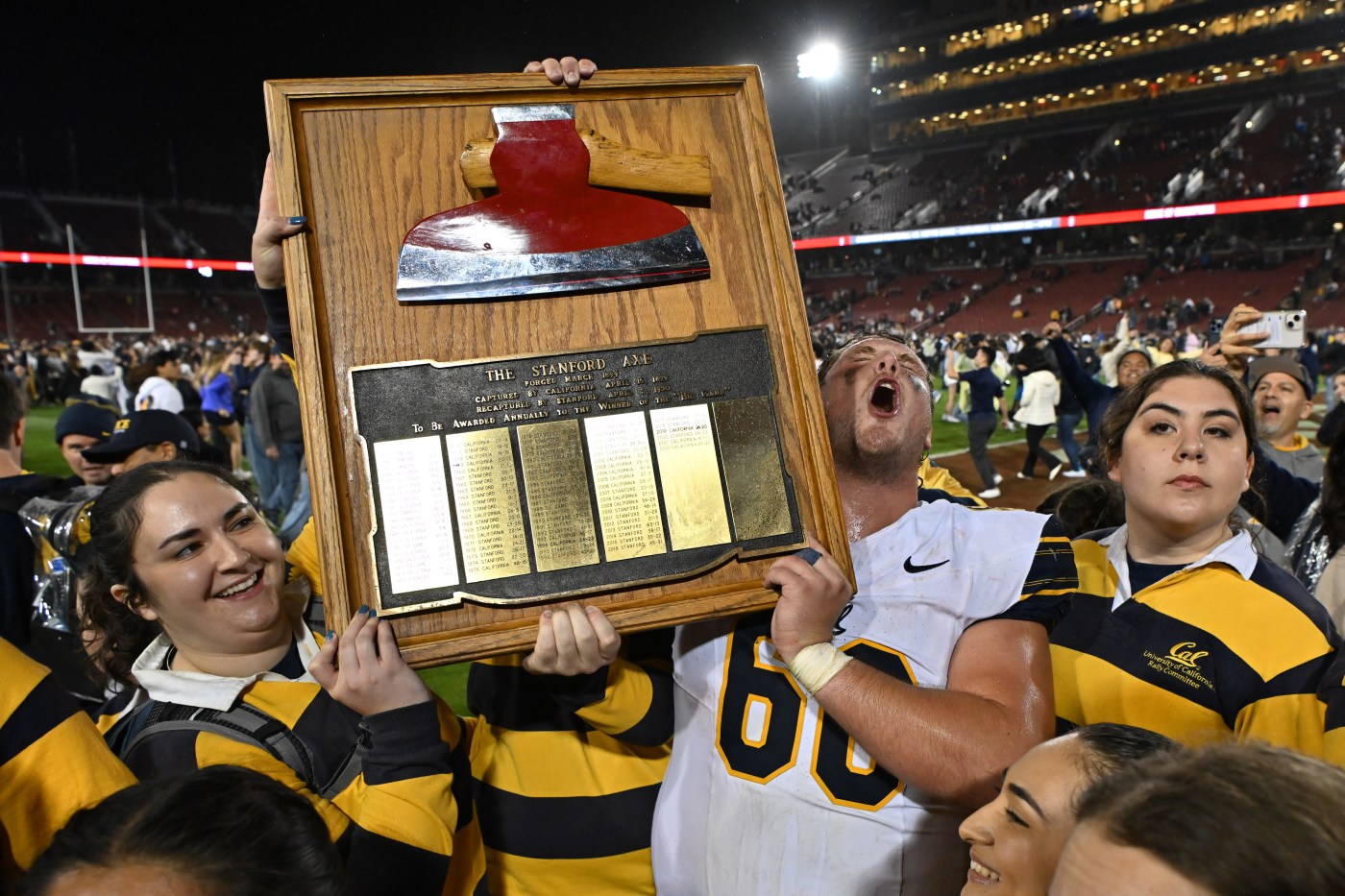Cal and Stanford officially join the ACC on Friday, marking a new era with fascinating competitive opportunities and one all-too-familiar problem.
A supermassive red hole threatens to swallow each school’s athletic budget.
Or as Cal vice chancellor for external communications Dan Mogulof told the Hotline via email: Life in the ACC carries “a revenue challenge.”
Officially, the Bears and Cardinal will be full-share members for 12 years. But according to Cal’s approval letter, which was obtained by the Hotline through a public records request, the Bears must “contribute” money back to the conference for nine years.
That contribution is more than a few million dollars here and there; it’s tens of millions, year after year.
As a private university, Stanford wasn’t bound to disclose its membership agreement, but the terms likely are identical to those in Cal’s deal. A spokesperson for the Cardinal’s athletic department told the Hotline (via email) that “similar to other new ACC members, we will be contributing a portion of our media distributions back to the conference for several years.” (Full statements from both schools are below.)
How does the ACC define “a portion” of the media distribution?
According to Cal’s membership letter, the contributions “back to the conference” are as follows:
— “67% of distributions of Media Revenue to Cal during each of the first 7 years following the Effective Date;
— “30% of distributions of Media Revenue to Cal during the 8th year following the Effective Date; and
— “25% of distributions of Media Revenue to Cal during the 9th year following the Effective Date.”
It seems Cal and Stanford paid a steep price for salvation.
Once the Pac-12 imploded on Aug. 4, 2023, with four universities headed to the Big Ten and four more to the Big 12, the Bay Area schools became desperate for a life raft.
Weeks of negotiating led to an agreement with the ACC, which is based in Charlotte and immersed in turmoil of its own. The top football schools, Florida State and Clemson, have filed lawsuits against the conference as a means of nullifying the grant-of-rights contract with ESPN that holds the ACC together. If the Seminoles and Tigers succeed, the conference could implode in the next two or three years, leaving Cal and Stanford adrift once again.
For now, though, the Bay Area schools are preparing for a prolonged stay on the Atlantic coast.
“Joining the ACC will provide Stanford with many benefits, including the competitive infrastructure, an affiliation with like-minded universities, and long-term media revenues that are critical for Cardinal student-athletes to compete nationally,” the spokesperson explained.
Cal believes the new home will provide “our student-athletes with the ability to successfully compete at the highest levels, and, at the same time, to thrive academically.”
But competing “at the highest levels” requires investment at the highest levels, and neither school can lay claim to an airtight budget.
Cal’s athletic department relies on roughly $30 million annually from central campus in order to balance the books.
Stanford’s fiscal issues are such that it eliminated 11 sports programs in 2020, only to reinstate them after a severe backlash. And last year, the Cardinal reported a $21 million operating shortfall despite $12 million in university support that was booked as revenue.
And now the schools must muster the cash necessary to remain competitive in the ACC despite the annual “contributions” back to the ACC.
To determine the total amount for each school over the 12 years, the Hotline first needed to define the term “media revenue” laid out in Cal’s membership letter. Fortunately, the fourth paragraph provides a framework:
“Media revenue shall mean all revenue generated and distributed from (i) the Amended and restated Multi-Media Agreement, dated July 21, 2016, by and among ESPN, Inc., ESPN Enterprises, Inc. (collectively referred to as “ESPN”) and the Conference … and (ii) the Network Agreement, dated July 21, 2016, by and among ESPN and the Conference, as amended from time to time (collectively with the Multi-Media Agreement, the “Media Rights Agreements”).
The wording suggests “media revenue” is the amount the ACC receives annually from its Tier 1 deal with ESPN (i) and the amount it receives from the ACC Network (ii), which is owned by ESPN.
In the 2023 fiscal year, the conference reported $481.7 million in TV revenue, according to its tax filings. That provides a starting point for our estimates, but media deals typically feature escalator clauses that increase the payments from the networks to the conferences each year. (The Pac-12’s broadcast agreement with ESPN and Fox, signed in 2011, included a 5.1 percent escalator, for example.)
For the ACC, we used $481.7 million as the starting point, added a 5 percent annual escalator, then calculated the annual revenue totals through 2036, when the ACC’s agreement with ESPN expires.
We then divided the annual total by 17 to simulate a full-share amount for each school. Finally, we applied the percentage deductions outlined in Cal’s membership letter to determine the net revenue expected for the Bears and Cardinal.
The result: Hotline projections show each of the ACC’s long-standing members will receive $497.5 million over the contract term, while Cal and Stanford will take home $302.1 million apiece.
Each school is $195.4 million behind its competition over the contract term.
Now, to be clear: Our calculations do not account for:
— Notre Dame’s share of the revenue. (The Irish are ACC members in all sports except football.)
— Increases in conference revenue resulting from the Bay Area and Dallas becoming home media markets for the ACC Network. (SMU joined the conference on July 1.)
— Media revenue allocated for performance-based allocations under the conference’s new financial model.
So that $195.4 million disparity noted above? It’s based on back-of-the-envelope math.
But any necessary revenue adjustments likely would apply to all 17 schools. The Bears and Cardinal might end up with more cash, but so will everyone else. Tallied with a fancy algorithm or an abacus, the revenue disparity is substantial: $16.3 million per year for each Bay Area school, on average.
And it comes at the worst possible time, as the power conference schools prepare to share revenue with athletes and increase the number of scholarships offered — both changes likely will be implemented in 2025 — following the settlement of an antitrust lawsuit against the NCAA.
Related Articles
Our radical ideas for the Big 12 football schedule as commissioner Brett Yormark seeks “value creation”
Mailbag: Metrics for Pac-12 expansion candidates, the CFP’s future, USC’s QB matchups, ASU’s expenditures, Foster’s remarks and more
How to count Paris Olympic medals for Pac-12 athletes before breakup
Big Ten football media days: What Petitti’s address says about the 18-school, bicoastal conference
Big Ten media days: Petitti’s address, West Coast arrivals & more
The new economic model is expected to add approximately $25 million to annual budgets for athletic departments in the ACC, Big Ten, Big 12 and SEC.
Combine the soaring costs with the transfer portal and NIL (name, image and likeness), and the Bay Area schools are facing the most challenging financial and competitive environment in their collective history.
How will they possibly compete “at the highest levels” on the field and court — not to mention in the pool and on the track — with a long-haul shortfall of $195.4 million?
Is there a plan to offset the nine-figure disparity?
Details are sparse on both campuses.
Yes, Cal has $10 million coming each of the next three years courtesy of a contribution from UCLA (as directed by the UC regents). But that controversial subsidy, which will be reassessed in 2027-28, doesn’t come close to covering Cal’s revenue deficit during that span.
The Bears also are examining “the role philanthropy can and should play” in funding athletics, according to the school.
Meanwhile, Stanford’s statement indicates the Cardinal will “work through the financial dimensions” of its ACC membership. The school has plenty of money. Will it increase annual transfers to athletics from central campus? Will it ask donors to bridge the revenue gap?
There are no good options, not with a nine-figure revenue disparity.
For the Bears and Cardinal, traveling cross-country for conference games could be the least challenging aspect of life in the ACC.
— Statement from a Stanford athletic department spokesperson:
“Stanford is excited to join the ACC. Joining the ACC will provide Stanford with many benefits, including the competitive infrastructure, an affiliation with like-minded universities, and long-term media revenues that are critical for Cardinal student-athletes to compete nationally. Stanford will join the ACC as a full member, both in terms of governance and media distributions. However, similar to other new ACC members, we will be contributing a portion of our media distributions back to the conference for several years. The level of these contributions will decrease over time, and we will work through the financial dimensions in a way that sustains excellence in our athletics program and our academic mission.”
— Statement from Cal vice chancellor for external communications Dan Mogulof:
“While the move to the ACC has created a revenue challenge, we are fortunate that our new Chancellor, Rich Lyons, is both well versed in financial issues and fully committed to protecting Cal Athletics’ excellence, and the essential role it plays in the life of the university.
“Chancellor Lyons is now in listening mode, getting up to speed on the details and the perspectives of our stakeholders, with a particular interest in the role philanthropy can and should play going forward, and an acute awareness of the stakes. We will keep the public and our community well informed as the planning and decision-making process progresses.
“Beyond the dollars and cents, there is a great deal of excitement here about officially becoming a member of the ACC on Friday. Providing our student-athletes with the ability to successfully compete at the highest levels, and, at the same time, to thrive academically, is and will remain our primary focus.”
*** Send suggestions, comments and tips (confidentiality guaranteed) to pac12hotline@bayareanewsgroup.com or call 408-920-5716
*** Follow me on Twitter/X: @WilnerHotline
*** Pac-12 Hotline is not endorsed or sponsored by the Pac-12 Conference, and the views expressed herein do not necessarily reflect the views of the Conference.












